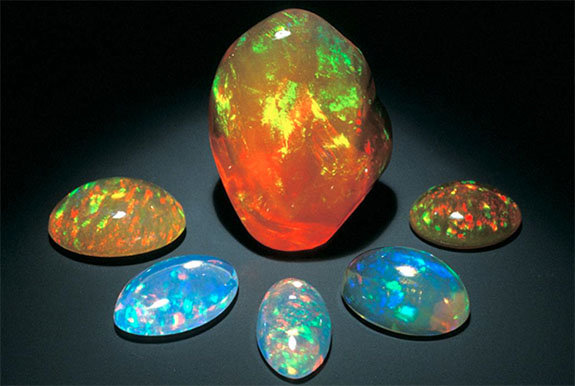Birthstone of the Month: Aztecs Likened Fire Opal to a 'Bird of a Thousand Colours'
The Ancient Aztecs used two special names to describe the vibrant and colourful fire opals they discovered in the region that is now Queretaro, Mexico. According to the Gemological Institute of America (GIA), the first was quetza litzle pyolitli, meaning “stone which changes colour in movement” and the second was huitzitziltecpatl, which meant “stone like a bird of a thousand colours.”

It's clear why the Aztecs believed fire opals were sacred stones that possessed mystical properties. The transparent and semi-transparent stones seemed to be ablaze with yellow, orange, red and blue body colour. The fire opals presented a fascinating "play-of-colour," which refers to the rainbow flashes seen when viewing the stone from various angles.
The GIA commented: "At times, the beauty of Mexican opal exceeds that found in opal from any of the world's better-known deposits, such as Australia."
The Mexican fire opal specimens shown above are part of the National Gem & Mineral Collection at the Smithsonian National Museum of Natural History in Washington, DC. The opals in this group range in weight from 11 to 143 carats and are excellent examples of October's birthstone. (Opal shares official October birthstone status with tourmaline.)
According to the GIA, fire opal in Mexico is believed to have formed over time as water seeped into silica-rich volcanic rock. Gradually, silica was deposited into cracks and voids in the rock and became opal.
Opals are categorized by their transparency and body colour. White opals, for instance, are translucent stones with a play-of-colour against a white body colour. When the vivid play-of-colour is seen against a black or dark body colour the specimen is called a black opal.
Fire opals have a vibrant body colour that resembles gelatin. According to the Smithsonian, the best fire opals are found in Mexico and the stones are sometimes called "Mexican opals." Opals are generally cut as cabochons or polished free-form to best show the play-of-colour.
According to the GIA, the most important opal deposits in Mexico are in the state of Queretaro, although there are other significant deposits in the states of Chihuahua, San Luis Potosi, Guerrero, Hidalgo, Jalisco and Michoacan.
An opal’s silica structure contains 3% to 20% water, according to the American Gem Society. The value of a fine opal is based on a number of factors, including brightness, colour, pattern, body tone and consistency (how it looks from multiple angles).
While Australia remains the primary source of fine opal production and Mexico is a well known source of fire opals, the October birthstone is also mined in Brazil, Honduras, Ethiopia, the Czech Republic and parts of the US, including Nevada and Idaho.
Credit: Photo by Chip Clark/Smithsonian.

It's clear why the Aztecs believed fire opals were sacred stones that possessed mystical properties. The transparent and semi-transparent stones seemed to be ablaze with yellow, orange, red and blue body colour. The fire opals presented a fascinating "play-of-colour," which refers to the rainbow flashes seen when viewing the stone from various angles.
The GIA commented: "At times, the beauty of Mexican opal exceeds that found in opal from any of the world's better-known deposits, such as Australia."
The Mexican fire opal specimens shown above are part of the National Gem & Mineral Collection at the Smithsonian National Museum of Natural History in Washington, DC. The opals in this group range in weight from 11 to 143 carats and are excellent examples of October's birthstone. (Opal shares official October birthstone status with tourmaline.)
According to the GIA, fire opal in Mexico is believed to have formed over time as water seeped into silica-rich volcanic rock. Gradually, silica was deposited into cracks and voids in the rock and became opal.
Opals are categorized by their transparency and body colour. White opals, for instance, are translucent stones with a play-of-colour against a white body colour. When the vivid play-of-colour is seen against a black or dark body colour the specimen is called a black opal.
Fire opals have a vibrant body colour that resembles gelatin. According to the Smithsonian, the best fire opals are found in Mexico and the stones are sometimes called "Mexican opals." Opals are generally cut as cabochons or polished free-form to best show the play-of-colour.
According to the GIA, the most important opal deposits in Mexico are in the state of Queretaro, although there are other significant deposits in the states of Chihuahua, San Luis Potosi, Guerrero, Hidalgo, Jalisco and Michoacan.
An opal’s silica structure contains 3% to 20% water, according to the American Gem Society. The value of a fine opal is based on a number of factors, including brightness, colour, pattern, body tone and consistency (how it looks from multiple angles).
While Australia remains the primary source of fine opal production and Mexico is a well known source of fire opals, the October birthstone is also mined in Brazil, Honduras, Ethiopia, the Czech Republic and parts of the US, including Nevada and Idaho.
Credit: Photo by Chip Clark/Smithsonian.

